Designing for safer Capital Region streets
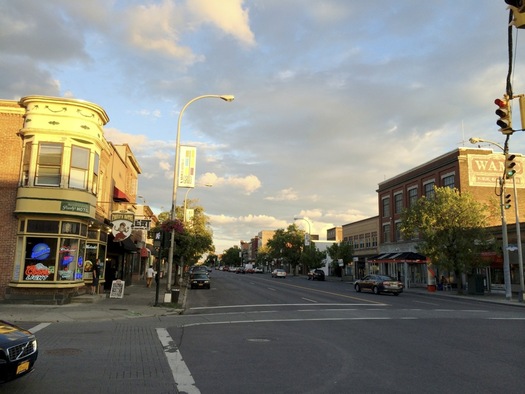
Central Ave at Quail Street in Albany.
Street safety has been a major topic of discussion in the Capital Region recently, from Albany's red light cameras to the Madison Avenue road diet to the death of a young boy in Albany and far too many others across the region. It's pretty clear that everyone agrees something must be done.
To a large extent, though, it seems that the discussion about road safety for all users has focused on more and better enforcement of existing laws as a solution to the toll. And while enforcement of speed limits and road safety -- which, in my experience, is pretty nonexistent in much of the region -- is absolutely part of the ultimate fix, the focus on it ignores that there is, in fact, a much more effective solution at hand: better design of our streets and roads.
Here are a few examples:
Swan Street
The section of Swan Street between Park Ave and Madison Ave in Albany is a frequent topic of discussion on the Hudson/Park Neighborhood Association listserv, to which I subscribe. It's easy to see why: these few blocks carry a relatively high volume of traffic for a neighborhood street, and the road is wide, one-way, and has an ambiguous number of lanes, all of which contribute to frequent speeding.
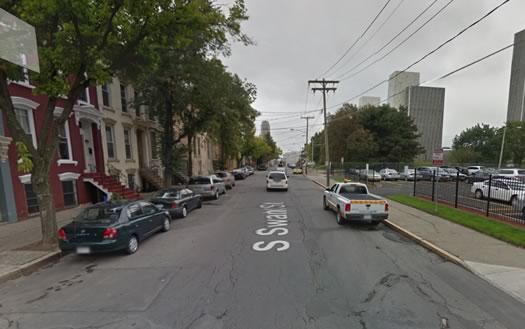
Swan looking north from Irving. Notice how it is unclear how many travel lanes there are. / image: Google Streetview
Wrong-way drivers turning south onto Swan from Madison have also been a problem, aided by the fact that at that intersection Swan widens completely unnecessarily to have dedicated right AND left turn lanes (neither of which is used particularly frequently).
Listserv discussion has focused on a "yield to pedestrians in crosswalk" sign that the city has repeatedly placed in the middle of one intersection, only to have it rarely last more than a few days before being run over yet again.
And therein lies the rub. Look: placing more signs isn't going to fix Swan's problems, and neither are increased patrols. Swan suffers from speeding because the street's design encourages it. To control the speeding and wrong-way drivers, the street has to be redesigned.
Let's start with the wrong-way problem. This is Swan looking south from Madison. Note how this neighborhood street -- which carries about 3,250 cars per day, on the high end for a neighborhood street but not that busy -- is effectively five lanes wide here. With street markings worn away, this looks inviting, and it's easy to understand why someone might assume it's a two-way street (hint: it looks like one).

image: Google Streetview
Now here's an illustration from the National Association of City Transportation Officials (NACTO) Urban Street Design Guide of the kind of low-key design intervention that could drastically cut down on the wrong-way problem (granted, the example is a two-way street, but it's not hard to imagine it applied to Swan):
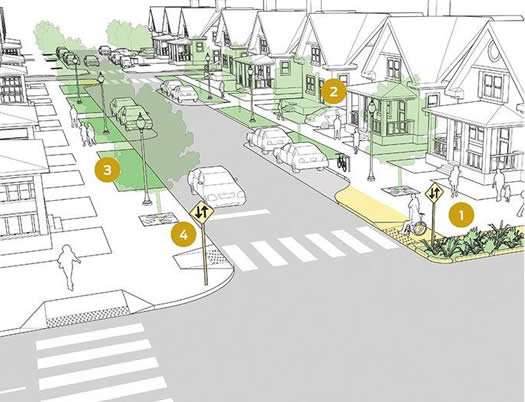
"Bumping out" one sidewalk corner eliminates a turn lane, but narrows the road considerably, reducing turning speed so that pedestrians are safer and (if this were a one-way street) making wrong-way turns physically impossible.
Central Avenue
I'll illustrate the lane width issue with another example, although the lessons apply to Swan as well. I and others have written about the dangers of Central Avenue in both its urban and suburban sections. However, political responses to the danger -- such as the NYSDOT-led See! Be Seen! Campaign -- have focused on modifying pedestrian behavior and enforcement, with only limited design intervention.
That's not going to work, because Central, like many other Capital Region roads, is -- to borrow a catchphrase from Smart Growth America -- dangerous by design.
Taking the section from Henry Johnson Boulevard to N. Allen Street in Albany as an example, the inner travel lanes are about 12 feet wide, and the outer ones more like 14 feet. Here's why that's a problem (again, from the NACTO Guide):
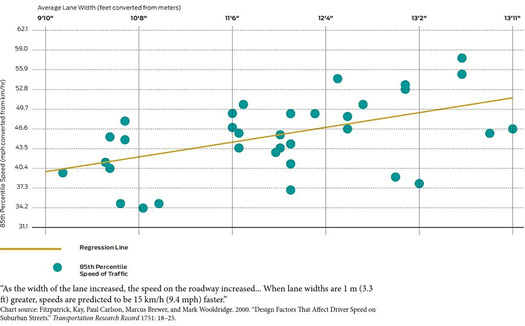
In the study sample, the 85th percentile speed (the speed below which 85 percent of cars were traveling) of cars in a 12-foot lane varied from 37 to almost 50 mph. And it's important because the 85th percentile speed is what road engineers use to, in theory, set a "rational" speed limit.
And that means that while Central has a fairly modest 30 mph speed limit in the section through Albany, the road is actually designed for much higher-speed traffic. Designing for that kind of speed is pretty close to obscene and irresponsible in an urban context -- and of course the incentive to drive that fast overwhelms any prospect for speed limit enforcement. No wonder, then, that NYSDOT's 2014 report on pedestrian safety in the corridor found that the 85th percentile speed on the Albany section of Central was well above the marked speed limit:
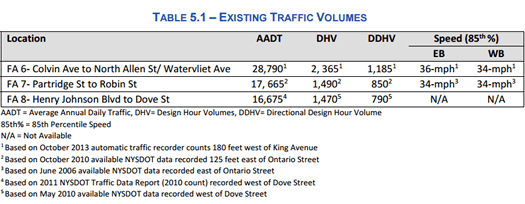
Think about that again: Some portion of the 85 percent of drivers on Central were doing 4-6 mph above the speed limit (and the other 15 percent were driving even faster). It's not surprising -- they were responding to design cues! 85th percentile speeds were above limits in other sections of the corridor as well, but not quite as drastically. This isn't something that increased enforcement can solve. Indeed, the 85th percentile speed paradigm is based on an outdated approach that considers only the safety of drivers, and assumes all crashes are equally dangerous (they're not).
So the speed limit on the urban section of Central is set well below the road's design speed. Should we not allow cars to go faster, then? Well, no. Vehicle speed has a huge impact on pedestrian mortality from crashes, the rates of severe injury or death from 25 percent to 50 percent as speed rises from 25 to 33 mph -- and car-pedestrian crashes tend to rise as car speeds rise. No wonder, then, that the NYSDOT report recommended studying a road diet on the Albany stretch of Central.
And there are numerous opportunities for such road diet interventions in the region. According to Eric Fischer's traffic count visualization, Central carries no more than 18,000 cars per day east of Manning -- below the Federal Highway Administration's recommended road diet threshold of 20,000 and well below NACTO's more generous threshold of 25,000. Madison Ave, where a road diet -- albeit an incomplete one -- is being implemented, carries no more than 15,000 cars per day. Washington Ave, one of Albany's broadest and fastest streets, carries fewer than 11,000 cars per day, and would be an ideal candidate for a road diet.
Better for everyone
The concern for road safety for all users is far from theoretical. Nor is it the province of starry-eyed utopian urbanist idealists. As Chris Churchill has documented repeatedly over at the Times Union, people of all kinds die in crashes. Our current road design is for the most part outdated and prioritizes free-flowing car traffic above all other concerns, including human safety. Typically, design improvements are hard to implement because many drivers see them as making their own lives more difficult. But better design -- design that emphasizes safety -- doesn't have to come with costs to drivers. Here in the Capital Region, we have a unique opportunity to achieve the best of all worlds; most, if not all, arterial roads in our urban sections are well below actual capacity and have significant ability to absorb design changes without impact to travel times.
As the Capital Region sees something of an urban renaissance, with residential development in new places, the issue of street safety is becoming more important than ever. Here's just one more example: A private dorm is set to open at the high-speed, high-volume intersection of Washington Ave and University Drive across from UAlbany's uptown campus, with another planned just down the road. Hundreds of students will be walking to class from these buildings -- and trying to cross a broad, dangerous road to get there. Will our road designers take them into account -- or will we continue to pin all of our hopes on a pursuit of enforcement, while neglecting safer design?
Sandy Johnston is finishing up his Master's in Regional Planning and a certificate in Urban Policy at UAlbany. He blogs at www.itineranturbanist.wordpress.com and is a vocal presence on Twitter @sandypsj. Before moving to Albany, Sandy had lived in New Jersey, Oregon, Iowa, Connecticut, Chicago, Jerusalem, and New York City. Sandy lives in Center Square/Hudson Park with his partner Gabriella, a state worker, and their two cats. You can reach Sandy with comments or complaints through his website.
Earlier on AOA:
+ What if tearing down I-787 could actually improve traffic?
+ Thinking about the direction of Central Ave
Hi there. Comments have been closed for this item. Still have something to say? Contact us.
Comments
Thank you! Yes please!
... said Randal Putnam on May 12, 2016 at 4:47 PM | link
I'm both a pedestrian and a driver so I can relate to both perspectives; that being said, I think many a pedestrian fatality can been avoided if the person crossed AT THE CROSSWALK. I cannot count how many times I've seen people cross the road (often at a leisurely pace) at locations that are typically 50 feet or less from a crosswalk.
Come on, people!
I realize the Capital District is only starting to be more aware of pedestrians, but having a clue to the obvious goes a long way. The signals are there for a reason. USE THEM.
... said Rebecca on May 12, 2016 at 8:33 PM | link
Great article. I was just thinking yesterday about how unnecessary the turn lanes on Swan at Madison are, and how much they contribute to that road feeling like a speedway. It's also interesting to read that both Central and Washington are within the guidelines for a road diet - I think both would benefit from it. If nothing else a narrowing of lanes on central would help to control speed and would make road width available for protected bike lines.
... said Mike D on May 12, 2016 at 10:03 PM | link
in re: Rebecca's comment, NYSDMV keeps pretty good accident report summaries. That link brings you to the statewide 2014 pedestrian/vehicle accident numbers. Of 268 collisions which resulted in a pedestrian fatality, 93 (35%) involved a pedestrian crossing with no marked crosswalk. The number for total accidents looks like it's around 21%. Take it as you will.
... said -B on May 13, 2016 at 9:00 AM | link
"I think many a pedestrian fatality can been avoided if the person crossed AT THE CROSSWALK."
Ashiqur Rahman WAS in the crosswalk, and he was killed anyways. The system DOESN'T WORK. In many cases I have felt safer crossing 50 feet away from the crosswalks because I only have to worry about cars coming at me from two directions instead of a potential four at intersections. Too many intersections in the Capital Region give pedestrians the cross signal at the same time cars get a left turn signal, and I see drivers ignore the "No right on red" signs all the time.
Stop victim blaming.
... said Sam on May 13, 2016 at 9:08 AM | link
Thank you for this!! Western Avenue is another problem area - especially as you get towards SUNY and the northway entrance. Trying to ride a bicycle east and west through that section is impossible and walking is almost as dangerous.
... said Gail on May 13, 2016 at 9:32 AM | link
Thank you for talking about design - it really is the only way to make streets safer. My question is, why is Swan street one way on that side anyway? I understand a one way starting at the ESP ramp, as that really throws a wrench in everything. As you show, it's clearly large enough to be two way, and one way streets encourage speeding, even without the super wide street. I'll never understand Albany's love affair with unnecessary one ways and I've live here all my life.
... said Beth M on May 13, 2016 at 9:45 AM | link
Excellent article. Lane ambiguity, or lack of proper roadway marking is a constant issue all over the city. For example, take the westbound stretch of New Scotland from Manning Blvd to Buckingham Drive: how many lanes are there actually? There are no pavement markings to indicate anything (and honestly, I still have no idea despite travelling that stretch often), and people FLY down that street at 45mph on a regular basis. Parking is also legal along the curb on both sides of the street, effectively rendering it a lane and half wide when parking does occur (especially near Maria college) - the only implication of two lanes is the split to veer right down Buckingham, or to continue straight on New Scotland.
... said -R. on May 13, 2016 at 9:46 AM | link
Rebecca, crossing only at the crosswalk makes no difference whatsoever. While it's a rule I usually follow, I've crossed many a street against the light in the middle of the block without an incident. The only times I've nearly been hit by cars in Albany were when I was cross at the crosswalk, with a green light and a walk signal. Until area drivers become even slightly less homicidal, things won't change.
... said JayK on May 13, 2016 at 9:56 AM | link
[Clicked post too soon.]
That's why I like the ideas presented here, because they convince the driver through the design of the road itself to behave in a less homicidal and dangerous manner. Blaming the victim for the results of years of designing only for cars at the expense of all others does not help, and I'm looking forward to the day when we can collectively get that through our heads.
... said JayK on May 13, 2016 at 10:00 AM | link
You forgot to mention that road diets often benefit small businesses!
Most published before-and-after results show increased or at worst neutral sales receipts after road diets. I only recall one study that showed a decline in sales.
The better studies also use sales at nearby stores on other streets to control for other effects.
... said Zed Fechten on May 13, 2016 at 11:17 AM | link
Repectfully, I am not victim blaming pedestrians who get hit at crosswalks. My peeve is that I notice (heightened awareness, perhaps) that when I am stopped (along with the cars in front of me and behind me) at a light I find it frustrating to see people crossing in between the STOPPED cars, while I am gazing right at the empty crosswalk. Or as I am slowing down for a red light (yes, some of us do that) a pedestrian will be crossing the street somewhere between my still-moving car and the crosswalk. I think it *does* make a difference to cross at a crosswalk since I do it regularly and I'm still alive to write this comment.
I'm not excusing the crummy drivers around here. But there are some crummy walkers around here, too.
... said Rebecca on May 13, 2016 at 11:27 AM | link
As a resident of Albany, I equate driving in the city to a video game. You're dodging bikers, runners, walkers, squirrels that dart out, other drivers, red light cameras, etc. I think it takes a combination of drivers slowing down and staying ultra alert and pedestrians being vigilant about their safety in an urban setting.
Pedestrians cannot assume a vehicle will look out for them. There have been many times running outside that I've had to be proactive and move around a car that would have hit me.
Additional signage or road diet will likely help but it is ultimately the drivers' and pedestrians' responsibility to ensure the safety of each other.
... said JPea on May 13, 2016 at 12:03 PM | link
Sam posted "Stop Victim Blaming"
We SHOULDN'T do that , but sometimes people, both in cars and on foot, carry the Right of Way claim to extremes. I was stopped at the intersection of Washington and Lark, ready to drive north on Washington. It was 9 PM and dark. I was watching the light AND the pedestrians. The light turned green and as it did a group stepped off of Townsend Park and crossed Washington against a red signal. If they had crossed seconds later I'd have been in the intersection and may not have been able to stop- but if I'd hit them they'd have claimed right of way. As it is I was close to being rear ended by the driver behind me who expected me to go through the intersection. We all have to use some common sense here.
... said Eric Scheirer Stott on May 13, 2016 at 12:13 PM | link
A very good read with great suggestions that would help this city. However, I will note that the significant lack of "Do Not Enter" or "Wrong Way" signs at the intersections of one-way streets in Albany is disturbing. At some intersections, there is only one one-way sign that is often obscured or damaged. I notice this problem almost daily at the intersection of State and South Swan, mostly with out of towners visiting the capitol complex. There is no doubt that redesigning curbing and pavement markings would be a great improvement, but better, not necessarily more, signage would help improve safety for pedestrians and drivers everywhere in the city.
... said Uncle Leo on May 13, 2016 at 12:36 PM | link
"...it is ultimately the drivers' and pedestrians' responsibility to ensure the safety of each other."
and the point is that this mentality simply doesnt work. evidence shows that user behavior will be dictated by the infrastructure much more effectively than a feeling of "responsibility," or even laws/enforcement.
... said Ed on May 13, 2016 at 1:12 PM | link
I didn't think we could ramp up the victim blaming anymore, but the homicidal drivers of Albany have tripled down.
Every time anything like this is posted, you'll almost immediately read a comment blaming the people walking, rather than the people who are surrounded by a weapon weighing a ton or more. This completely takes the focus off the constantly dangerous behavior of area drivers and puts the blame on pedestrians instead. Yes, people shouldn't cross in the middle of the street, but it's always going to happen, and by focusing only on that, Rebecca, you are in fact excusing the crummy drivers.
Eric, I agree it's annoying when people do that, but if you can't stop in that amount of time *within an intersection*, you are driving WAY too fast and need to slow down and keep it slow. That is an egregious example of dangerous driving. If you had hit them, they'd be perfectly justified in claiming the lawful right of way. It's likely you'd face no penalties, as is far too often the case, but in my opinion you'd deserve to have your license revoked at that point.
... said JayK on May 13, 2016 at 2:15 PM | link
As a long-time (now former) resident of Colonie, I would add that Central Avenue is equally dangerous outside the city. There have been numerous pedestrians injured or killed while crossing Central Avenue between the Albany city line and Route 155. A big part of the problem (outside the Colonie Center area) is the lack of crosswalks for long stretches. Traffic calming is also needed to deal with drivers who seem to think that the wide lanes give them license to speed.
... said Ellen on May 13, 2016 at 3:31 PM | link
Man, people get upset when you say that pedestrians in Albany can be reckless! I have seen many (daily) instances of people darting across the street on Madison and Western, sprinting to get across in front of the traffic. Even better is when they do it after dark, so you can barely see them running out from between the parked cars in the middle of the block. I'm not saying that the drivers aren't just as bad, but to say this is "victim blaming" seems a little over the top to me.
... said LC on May 13, 2016 at 4:42 PM | link
I'd like to start with the commentary first...
I'm starting to believe the driving behavior in Albany is getting worse, I don't know how it can be getting that way but it is. I can count at least 10 times ppl ignore stop signs a day. It took putting up cones on New Scotland to stop ppl from making illegal left turns *to drop off their kids at the elementary school*.
As for swan st, I can only imagine that the 3 lanes was to pack in as many cars in whatever direction the people happen to be going. It can get busy. As there is no right on red there (which predates the other?) there doesn't seem to be a need for a right and straight lanes. However there may be bus issues that make the larger intersection necessary. See link for intersection https://www.google.com/maps/@42.6496377,-73.7637789,3a,60y,28.01h,82.6t/data=!3m6!1e1!3m4!1s8SSbff226yrW7TA2qovrqQ!2e0!7i13312!8i6656
... said Brian on May 13, 2016 at 7:41 PM | link
I have to whole-heartedly agree that engineering is largely to blame. I live right off Washington Avenue near Colvin and drivers treat this city street as a *highway* because it's designed as a highway! The lanes are very wide, there's no median, and the speed limit shifts from 45 to 30 in a matter of yards even though most drivers go at least 10 mph above the posted speed limit. It's a disgrace as there are many pedestrians especially around Homestead and Winthrop with the Danker Village apartments and then many other pedestrians further up near Colvin because of all of the stores like Hannaford and the Asian Supermarket. City streets that have been redesigned to slow traffic like Delaware Avenue near the Spectrum have lower speeds (even though drivers still go too fast). Essentially drivers will go as fast as the engineering allows. They'll drive as fast as they feel comfortable driving, and open, wide lanes allow people the comfort to drive up to 55 miles per hour in some of these city neighborhoods.
... said Paul on May 14, 2016 at 7:56 AM | link
I don't see it as victim blaming so much as a very common - and very selfish - behavior. For want of a better description, I'll call if responsibility shifting.
What can someone else do to solve the problem, so that I don't have to change my behavior?
If people walking used crosswalks, it wouldn't matter if I speed, or roll through right turns on red, or whatever.
Yes, people who walk or bike accept some risk when using a road or street, but that risk is imposed by people in motor vehicles and too I often exacerbated by poor street design.
... said Zed Fecten on May 14, 2016 at 6:45 PM | link
A question I would purpose to the city of Albany is why the red lights on certain streets are not coordinated for more efficient travel? Take for example the stretch of Washington Ave starting around Lark heading toward the Capitol I almost always hit each of those red lights. I feel this encourages speeding to try to make the next green light. Most times no matter how fast you go, you end up having to hard break at the next red light. If Albany could take lesson from NYC they would coordinate these lights so that if you go the speed limit, you would hit each one as it turns green.
... said Craig on May 15, 2016 at 2:14 PM | link
Interesting statistics - nationwide, not local, but probably still somewhat close:
36% of drinking age (16-85) killed pedestrians were above 0.08. 25% of casualties in 16-20 age group, and almost 50% for 21-55 were under influence.
http://www-nrd.nhtsa.dot.gov/Pubs/812124.pdf
... said Mike on May 15, 2016 at 10:14 PM | link
LC, sorry, but at its essence, this is victim blaming. I'm not excusing reckless walking behavior, but the fact that this is the major focus,*on a post about designing roads so cars are less likely to be so dangerous* illustrates just how misplaced (y)our priorities are. As I've said repeatedly, the only close calls I've had so far in Albany were while legally crossing in a crosswalk with the green light. I cannot be outside for even a few minutes anywhere in the city without seeing grossly negligent driving behavior. This is the problem. Not those mostly theoretical people crossing the street between parked cars in the middle of the night right in front of you, who are only putting themselves in danger.
Let's keep the focus on designing roads to tame the increasingly overwhelming proportion of dangerous drivers instead of only on the occasional reckless pedestrian.
... said JayK on May 16, 2016 at 11:42 AM | link
And on that note, I love the focus on Central Ave between Henry Johnson and N. Allen. There are effectively two Central Avenues and N. Allen is an appropriate boundary between the two. To the west is the strip mall based high-speed arterial and to the east is, with the exception of the road design, a walkable urban avenue of the sort you'd find in the northern neighborhoods of Manhattan. I'd love to see a road diet on this stretch, with protected bike lanes of the sort that sadly were not included on Madison. As it is, the street communicates to drivers that their cars are all that matters, and those people walking around are an afterthought.
Also, in perhaps an even more obvious case, Washington Ave between Lark and Brevator should not exceed one lane in each direction, though you could certainly justify a central turn lane. A 4-3 road diet is perfect for this street, possibly even more so than Central.
... said JayK on May 16, 2016 at 12:06 PM | link
Two important points were brought up in this article, the first being that simply enforcing our current laws is not working and changes to design standards [and current laws] are hard to implement because of how they are perceived by drivers.
In order to make our streets safer and more accessible for all users, we need to begin viewing road design and use through a different lens. In Troy, Capital Roots and Transport Troy created a Complete Streets ordinance that was voted second best in the nation by Smart Growth America. This duo has been implementing well-known practices like increasing bike lanes in the city along with innovative ideas like Creative Crosswalks in order to bring attention to bicyclists and pedestrians on the road and change the current conception that roads are solely for drivers.
Too often drivers object to the creation of more complete streets because it’s seen as an attack on the driving community. When roads are properly designed, however, the reality is that everyone is safer and able to travel more freely. Roads become less congested and travel times between two points decrease, which benefits drivers as much as cyclists and pedestrians.â€
... said Erin on May 20, 2016 at 11:43 AM | link